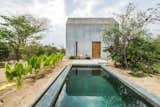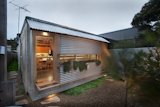Collection by Faco Javie
Dpto...
Lyle Bradley spent years of weekends and evenings resurrecting an East Boston structure using his carpentry skills, repurposed materials, and clever space-saving interventions. The revitalized 800-square-foot residence joins a rejuvenated backyard, where Bradley’s wife, Kara Lashley, and their daughter, Lily, pose next to Bradley’s new freestanding workshop.
Storey calls this house the “Eel’s Nest,” after the narrow urban properties that go by that name in Japan. Its façade was originally going to be wood, but because of local building codes and the fact the building is built along the edge of the property line, the exterior had to be fireproof. Storey covered it with stucco instead. “I wanted it to look as rough as possible,” says the architect. “Since it’s such a small house, it needed to be tough-looking.”
The workshop at ground level measures less than 200 square feet, but is set up to accommodate any kind of woodworking or welding; when not in use, the architect parks his car inside.
Langston-Jones, who grew up in Malaysia and Hong Kong, was attracted to corrugated metal for its its unique edges and visible flecks of material. He left the original 1920s corrugated steel roof and filled the interior with panes of the same material, as well as walls of sanded concrete and a concrete slab. “Inside and outside, there’s only one set of finishes, which succeeds in drawing the outside inside,” he says. “The climate here is wonderful, you can virtually live outside.”
A band of precast concrete, which holds a custom bench, wraps around the downstairs living area. The striped cushion fabric was purchased in Antwerp. A wood-framed AP71 lounge chair by Hans Wegner and a seat by Wim Rietveld, the son of famed Dutch designer Gerrit Rietveld, outfit the space. Underfloor heating installed throughout the house allows for a flexible layout: “There aren’t any radiators cluttering up the rooms,” Jeffries explains.
9 more saves



















